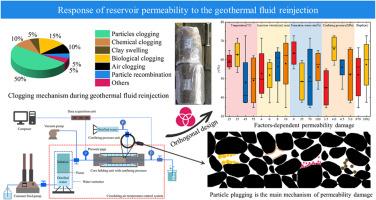Orthogonal experimental investigation on permeability evolution of unconsolidated sandstones during geothermal fluid reinjection: A case study in the Minghuazhen Formation, Tianjin, China
IF 9
1区 工程技术
Q1 ENERGY & FUELS
引用次数: 0
Abstract
Geothermal fluid reinjection (GFR) is vital for sustainable sandstone hydrothermal geothermal resource extraction. However, the permeability damage mechanisms of sandstone geothermal reservoirs due to reinjection remain unclear. This study aimed to investigate the permeability evolution of unconsolidated sandstone during GFR through an orthogonal experiment. The influence mechanism of the factors, including temperature, injection rate, confining pressure, geothermal fluid concentration (GFC), and depth, on sandstone permeability is also discussed. The results showed the sandstone samples suffered permeability damage in 34.62–72.73 %. Particle clogging emerged as the primary mechanism responsible for the permeability damage, serving as a crucial bridge in understanding the influences of the factors on sandstone permeability. Efficient GFR requires the optimization of reinjection conditions tailored to the characteristics of geothermal reservoirs. Sensitivity analysis showed that the order-sensitive characteristic of permeability damage to the factors was injection rate > GFC > temperature > depth > confining pressure. Through the optimization of reinjection parameters, the heat exploitation performance under the worst permeability damage case can be improved by 1.77–1.93 times. This study could offer valuable insights into the challenges and considerations associated with GFR in sandstone reservoirs.

地热流体回注过程中未固结砂岩渗透率演化的正交实验研究:中国天津明化镇地层案例研究
地热流体回注(GFR)对于砂岩热液地热资源的可持续开采至关重要。然而,回注对砂岩地热储层渗透率的破坏机制仍不清楚。本研究旨在通过正交实验研究 GFR 过程中未固结砂岩的渗透率演化。同时还讨论了温度、注入速度、约束压力、地热流体浓度(GFC)和深度等因素对砂岩渗透率的影响机制。结果表明,砂岩样本的渗透率损坏率在 34.62%-72.73% 之间。颗粒堵塞是造成渗透性破坏的主要机制,是了解各因素对砂岩渗透性影响的重要桥梁。高效的 GFR 需要根据地热储层的特点优化回注条件。灵敏度分析表明,渗透率破坏对各因素的阶次敏感特征为注入率、GFC、温度、深度和约束压力。通过优化回注参数,最严重渗透破坏情况下的热开采性能可提高 1.77-1.93 倍。这项研究可以为砂岩储层中的 GFR 相关挑战和注意事项提供有价值的见解。
本文章由计算机程序翻译,如有差异,请以英文原文为准。
求助全文
约1分钟内获得全文
求助全文
来源期刊

Energy
工程技术-能源与燃料
CiteScore
15.30
自引率
14.40%
发文量
0
审稿时长
14.2 weeks
期刊介绍:
Energy is a multidisciplinary, international journal that publishes research and analysis in the field of energy engineering. Our aim is to become a leading peer-reviewed platform and a trusted source of information for energy-related topics.
The journal covers a range of areas including mechanical engineering, thermal sciences, and energy analysis. We are particularly interested in research on energy modelling, prediction, integrated energy systems, planning, and management.
Additionally, we welcome papers on energy conservation, efficiency, biomass and bioenergy, renewable energy, electricity supply and demand, energy storage, buildings, and economic and policy issues. These topics should align with our broader multidisciplinary focus.
 求助内容:
求助内容: 应助结果提醒方式:
应助结果提醒方式:


